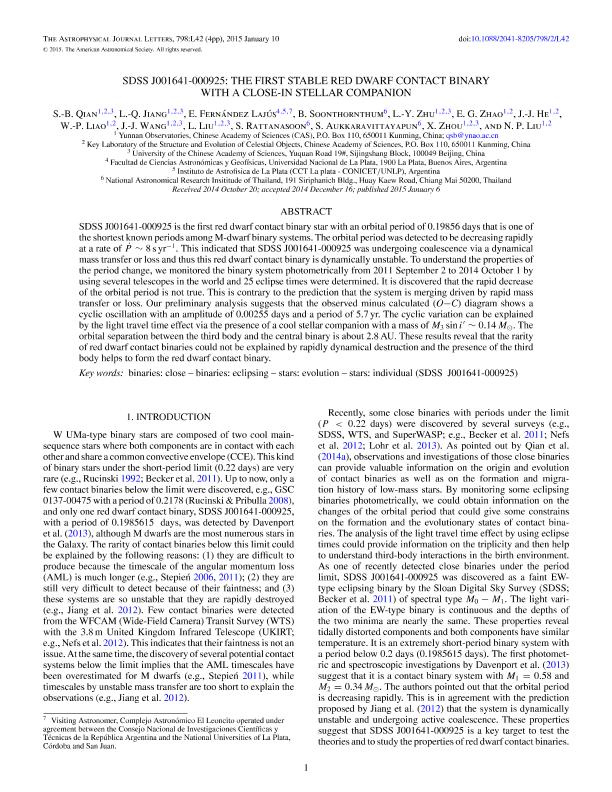Artículo
SDSS J001641-000925: the First Stable Red-dwarf contact binary with a close-in stellar companion
Qian S. B.; Jiang, L.Q.; Fernandez Lajus, Eduardo Eusebio ; Soonthornthum B.; Zhu, L. Y. ; Zhao, E. G. ; He, J. J. ; Liao, W. P. ; Wang, J. J. ; Liu, L.; Rattanasoon, S.; Aukkaravittayapun, S.; Zhou, X.; Liu, N. P.
; Soonthornthum B.; Zhu, L. Y. ; Zhao, E. G. ; He, J. J. ; Liao, W. P. ; Wang, J. J. ; Liu, L.; Rattanasoon, S.; Aukkaravittayapun, S.; Zhou, X.; Liu, N. P.
 ; Soonthornthum B.; Zhu, L. Y. ; Zhao, E. G. ; He, J. J. ; Liao, W. P. ; Wang, J. J. ; Liu, L.; Rattanasoon, S.; Aukkaravittayapun, S.; Zhou, X.; Liu, N. P.
; Soonthornthum B.; Zhu, L. Y. ; Zhao, E. G. ; He, J. J. ; Liao, W. P. ; Wang, J. J. ; Liu, L.; Rattanasoon, S.; Aukkaravittayapun, S.; Zhou, X.; Liu, N. P.
Fecha de publicación:
01/2015
Editorial:
IOP Publishing
Revista:
Astrophysical Journal Letters
ISSN:
2041-8205
Idioma:
Inglés
Tipo de recurso:
Artículo publicado
Clasificación temática:
Resumen
SDSS J001641-000925 is the first red-dwarf contact binary star with an orbital period of 0.19856 days that is one of the shortest known periods among M-dwarf binary systems. The orbital period was detected to be decreasing rapidly at the rate of dP/dt ~ 8 s/yr. This indicated that SDSS J001641-000925 was undergoing coalescence via a dynamical mass transfer or loss and thus this red-dwarf contact binary is dynamically unstable. To understand the properties of the period change, we monitored the binary system photometrically from September 2, 2011 to October 1, 2014 by using several telescopes in the world and 25 eclipse times were determined. It is discovered that the rapid decrease of the orbital period is not true. This is contrary to the prediction that the system is merging driven by rapid mass transfer or loss. Our preliminary analysis suggests that the Observed-Calculated (O-C) diagram shows a cyclic oscillation with an amplitude of 0.00255 days and a period of 5.7 years. The cyclic variation can be explained by the light-travel time effect via the presence of a cool stellar companion with a mass of M3 sin i′ ~ 0.14M⊙. The orbital separation between the third body and the central binary is about 2.8AU. These results reveal that the rarity of red-dwarf contact binaries could not be explained by rapidly dynamical destruction and the presence of the third body helps to form the red-dwarf contact binary.
Archivos asociados
Licencia
Identificadores
Colecciones
Articulos(IALP)
Articulos de INST.DE ASTROFISICA LA PLATA
Articulos de INST.DE ASTROFISICA LA PLATA
Citación
Qian S. B.; Jiang, L.Q.; Fernandez Lajus, Eduardo Eusebio; Soonthornthum B.; Zhu, L. Y. ; et al.; SDSS J001641-000925: the First Stable Red-dwarf contact binary with a close-in stellar companion; IOP Publishing; Astrophysical Journal Letters; 798; 2; 1-2015; 42-45
Compartir
Altmétricas



